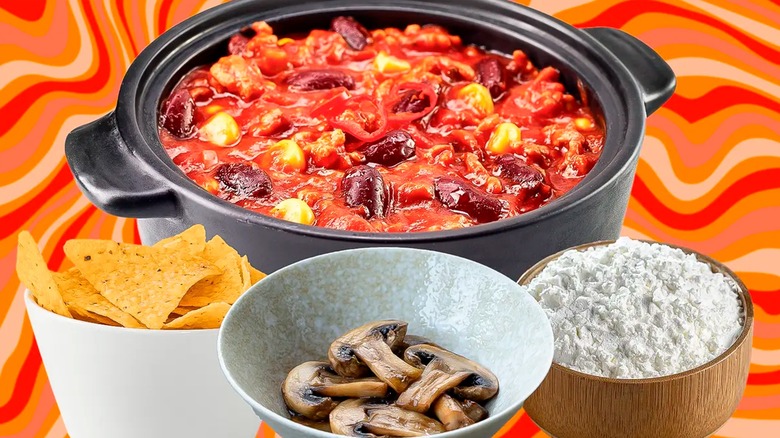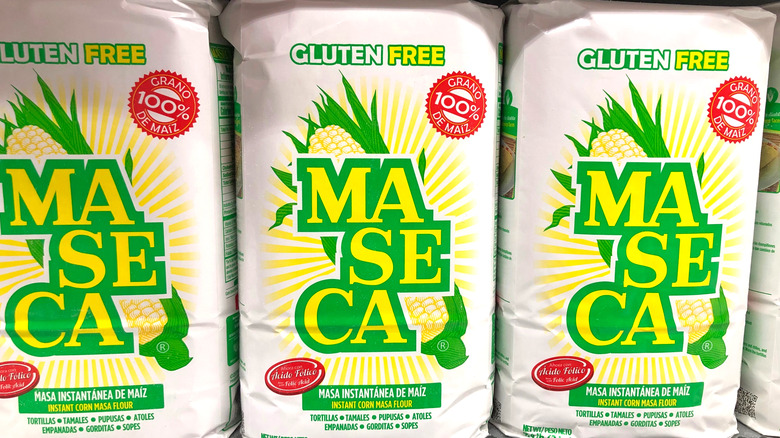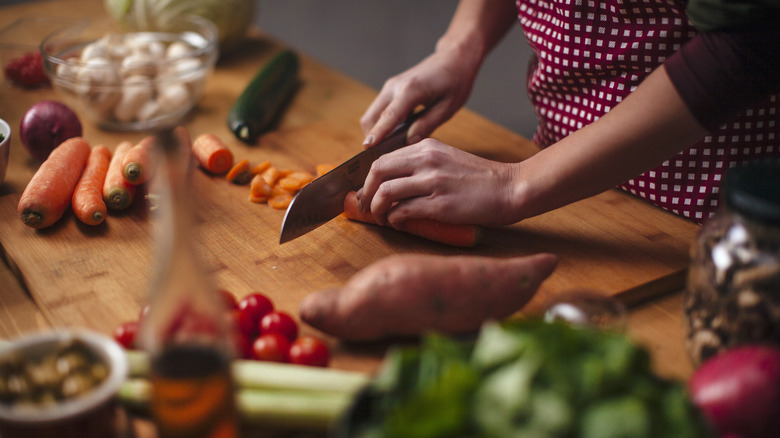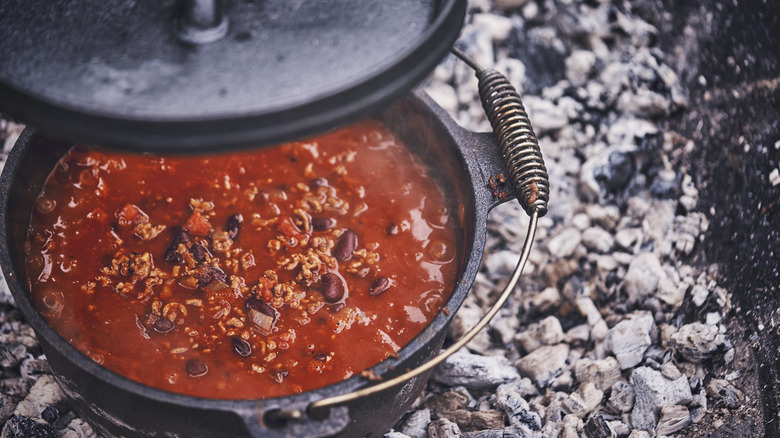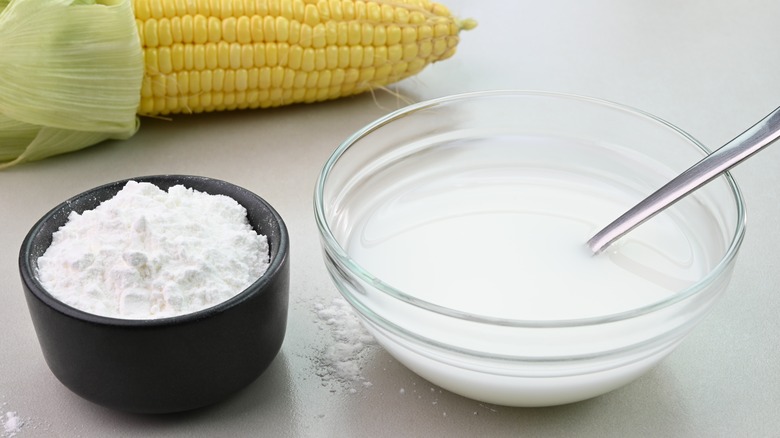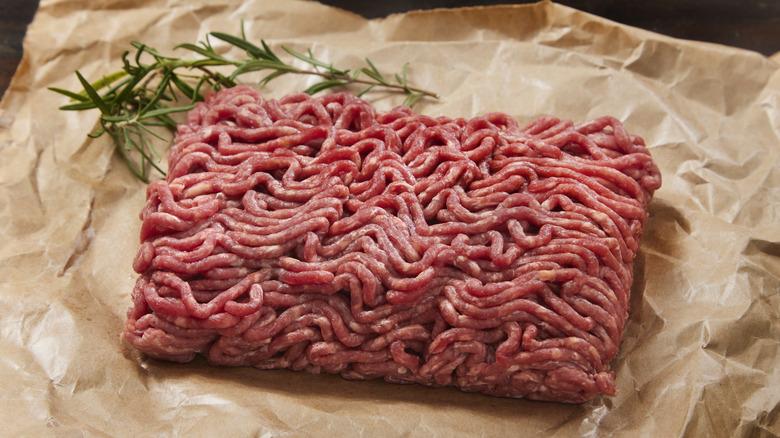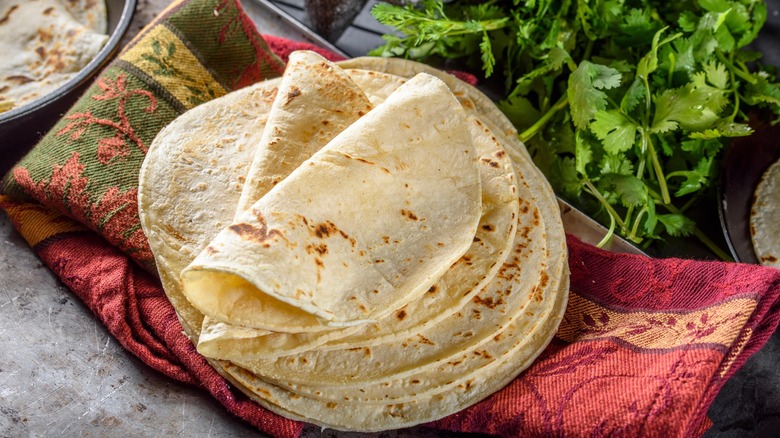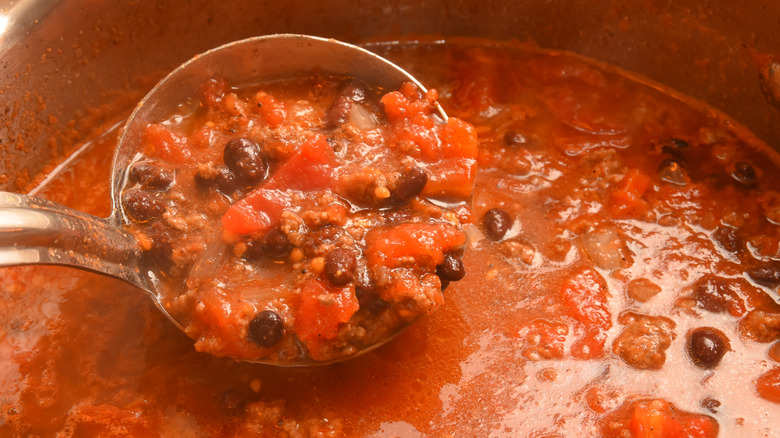8 Simple Ways To Thicken Your Next Batch Of Chili
No matter how you define chili, this dish is timeless and widely adored. It's the perfect default if you're not sure what to bring to a barbecue or potluck, and it's the go-to meal for cooking competitions. Families pass down recipes, and restaurants often boast of unique chili formulas to earn them local fame and admiration. Chili enthusiasts continue the longstanding debate over whether chili should contain beans or adhere only to a strict meat-and-pepper base, but in reality, chili knows no bounds. Any combination of meat, beans, veggies, spicy peppers, and seasonings can define a family's culinary history, or mark the start of new traditions. Ultimately, chili is much more than a meal; it tells a story.
Whether you're on team beans or team meat, you've likely encountered the frustrating mishap that happens when crafting any kind of stew-like dish: excessive water. Watery, runny chili ruins an otherwise delicious, savory, and spicy meal, and renders it useless as a hot dog topping.
In this list, we'll discover multiple methods for reducing surplus water in chili, so you can craft your family's time-honored specialty or experiment with newfound chili recipes. Some tips and tricks for achieving a flawless consistency require more time and additional ingredients, while others offer a quick fix in a pinch. Whatever your situation may be, you're bound to find the ideal solution to cure this common chili catastrophe.
Mix in masa harina or cornmeal
One of the oldest tricks in the chili-thickening book is still considered the most efficient method of absorbing water in the dish. The simple addition of masa harina, made from ground corn, adds subtly savory flavor and helps to achieve chili's signature thick consistency.
Those unfamiliar with Latin cuisine may be unaware of the power that lies with this humble ingredient. Masa harina has similarities with corn flour, but the kernels are soaked in an alkaline liquid before being ground, maximizing the corn's protein content. Meaning "flour dough" in Spanish, masa harina acts as a necessary ingredient in a variety of Mexican, Central American, and South American recipes.
Masa harina is the ingredient you need for thicker, more flavorful chili. Simply mix it with some water and add it to your pot while the chili is still hot. Allow the chili to simmer for a few moments, and then sample it to test whether or not the desired consistency was achieved. If not, slowly add more and more masa harina until your chili is perfectly thick. This is also one of the best ingredients to thicken homemade soup, as long as the flavor of the masa harina won't negatively impact the soup's taste profile. However, if you don't have access to masa harina and your chili is looking thin, apply this same trick with cornmeal. Imparting a similar (though less savory) flavor as masa harina, cornmeal is also an effective thickener.
Add dense veggies to thicken chili
One surefire way to ensure that your chili will be thick is to craft one loaded with chunks of dense, savory vegetables. Squash, eggplant, carrots, sweet potato, and cauliflower add flavor, texture, and necessary vitamins and nutrients to your dish, while still retaining that signature chili essence. Add veggies to chili made with or without meat; either way, you're packing in healthful benefits while increasing the number of ingredients that make chili better, any of which may end up in the family recipe book and be passed down for years to come.
You can start with a veggie-packed chili recipe, or just keep some chopped vegetables handy to add to a standard meat-and-bean chili if the dreaded moisture starts encroaching. Use the aforementioned vegetables along with fresh onion and bell pepper for nuanced flavors and color that make your dish come alive.
To prepare the vegetables, decide which types of knife cuts work best for the kind of chili you're crafting. A rondelle cut creates an elegant chili, while a rough chop gives your dish rustic, homestyle appeal. Additionally, a medium or small dice is necessary for a chili that will top hot dogs or be used as a chip dip. Any way you slice it, your chili will be delicious with a variety of added vegetables, and keep pesky water buildup at bay.
Mash the beans with varied kitchen tools
If you're completely satisfied with the flavor of your chili and don't want to risk including or eliminating any taste profiles, don't fret about adding or subtracting ingredients to thicken your dish. One of the simplest ways to quickly thicken chili without imparting new flavors or reducing its components requires a common kitchen tool, possibly a little elbow grease, and nothing more.
Use either a potato masher, food processor, or immersion blender to mash the beans. This creates a base to thicken the water or stock simmering in your chili pot, providing a quintessential chili texture and consistency without altering the taste.
To thicken chili using this method, remove some of the beans from the pot, straining any liquid from them. Any of the best types of beans for chili are suitable for mashing, but dense kidney beans make the thickest base. Use a potato masher to crush the beans, or plop them in a food processor and blend away. Be sure not to blend the beans excessively; they should be the consistency of hummus when you add them back to the pot. If you don't have either of these tools on hand, use an immersion blender. This no-mess method is the quickest and easiest way to thicken chili. Just stick the immersion blender in the chili pot and pulse a few times, stirring after every few pulses, until the beans are mashed and your chili reaches the desired thickness.
Uncover and simmer your chili to thicken it
If you're looking to enhance thickness in a pot of chili with no tools or additional ingredients, there's a simple, tried-and-true method that requires nothing but time. One of the most common mistakes with homemade chili is not letting it simmer long enough. Chili thickens easily when it's left to simmer uncovered on low heat. You don't need to add or remove anything from the pot, but you will need a few extra minutes, so if you're pressed for time, try another method from this list.
To thicken chili by simmering, simply turn the heat down to low and remove the pot's lid. Removing the lid ensures that excess water burns off, creating a thicker chili with little to no difference in flavor. If your chili is extremely runny, let it simmer for awhile, but don't stray too far from the stove; you'll need to stir the mixture frequently to prevent the ingredients on the bottom of the pot from burning.
A cornstarch or flour slurry will thicken chili
In addition to masa harina, cornstarch and flour are excellent additions for a chili that needs to be thickened up a notch. Cornstarch and wheat flour don't alter the taste of the dish, so if your chili's flavor is perfectly on point but its consistency needs work, cornstarch and flour are your friends for the (seemingly) daunting task at hand.
To use either flour or cornstarch in chili, you'll need to make a slurry to be added in the middle or towards the end of the cooking process. The difference between a slurry and a roux is that a roux is prepared first to give a dish a thick base. Typically, gumbo and gravy are associated with a roux, while a slurry is more appropriate to thicken most other dishes.
To make the slurry, mix roughly equal parts cornstarch and water (or 3 tablespoons of flour and a half cup of water), making sure there are no clumps in the mixture before adding it to the chili. Once incorporated, bring the chili to a rolling boil for a few minutes, or else the cornstarch will be rendered useless or the flour slurry will leave a pasty, unpleasant flavor. Taste-test the chili and add more of the slurry as needed. Never add raw flour or cornstarch directly to a batch of chili — you'll be left with starchy clumps throughout.
Incorporate ground beef or sauteed mushrooms
If you're in the process of creating a beans-only chili, it may seem counterintuitive to add meat in the middle of crafting the meal. Yet a watery chili is saved with the addition of ground beef — or mushrooms to keep your chili meat-free. Beef or ground mushrooms combine with the excess water, creating a thick base for beans and spices, while only slightly affecting the flavor and making all the difference in the texture department.
If your chili is runny and you have a package of ground beef on hand, brown the beef in a pan and slowly add it to the chili. You'll notice that the texture and consistency change dramatically with this addition. Beef absorbs the chili's moisture, turning a watery mess into a meal loaded with the savory flavors of succulent beef.
Alternatively, while it may be an unusual ingredient in vegetarian chili, add mushrooms. Simply sauté button or portobello mushrooms, making sure to cook them long enough so that any excess water cooks out. Then, transfer the mushrooms to a blender or food processor and blend them until they resemble the consistency of ground beef. Add the ground mushrooms to the chili, and experience disbelief when you can hardly tell beef-based and mushroom chili apart.
Use crushed corn chips or shredded tortillas in chili
Gone are the days when tortilla chips were considered only as one of the best toppings for chili. If you're no stranger to starchy flavors, and in fact prefer a little grit in your chili, keep a bag of tortilla chips or some flour or corn tortillas on hand before crafting your next batch. A watery meal is cured with this simple addition, and a little salty flavor is added to complement the seasonings to spice up your chili, enhancing its spicy and earthy taste and aroma. Tortillas and corn chips also up your chili's fiber content, making your meal all the more wholesome.
If you have a bag of tortilla chips on hand, crush them up by hand and add them to your watery chili. Leave some larger chunks if you want to be able to detect the dense, starchy bits floating among the beans, or crush them into a sand-like powder for a more sneaky addition. If your house is stocked with tortillas, either corn or flour, you can also add them to a batch of chili by shredding them by hand or with a knife. Toss the tortilla strips into the chili and let it simmer for a few minutes. The tortillas will begin to break down and contribute to a thicker base that the delectable beans and savory meat will nestle into.
Ladle out some liquid and heat it separately
This trick for thickening chili is ideal for anyone who lacks access to additional ingredients and has no time to spare. The only thing you'll need is a ladle and a pan or wok. If your chili is set to simmer and you start to notice water building up as the clock ticks away, simply remove the liquid from the pot of chili and reduce it in a separate cooking apparatus. This method is essentially the same as simmering the chili in order to reduce it and limit its water content, but the process is expedited with one easy step.
Grab the deepest ladle you can find and scoop the liquid directly from the pot of chili before adding it to a pan, turning up the heat, and boiling it down. After enough water has cooked off to your satisfaction, add the concentrated liquid back to the batch of chili. Its flavor won't be affected and no add-ins are required.
If you don't have a pan available to accomplish this task, a wok works in a pinch, but a pan is preferred if time is running out. Using a pan allows more of the liquid's surface area to heat up, thus reducing it faster.
Static Media owns and operates Tasting Table and The Daily Meal.
